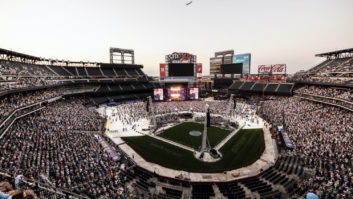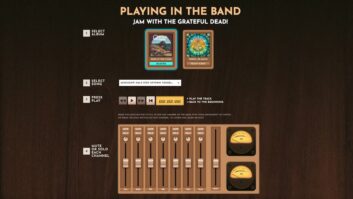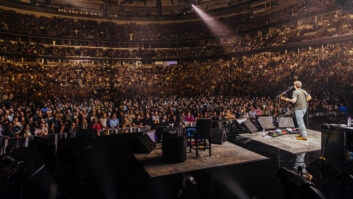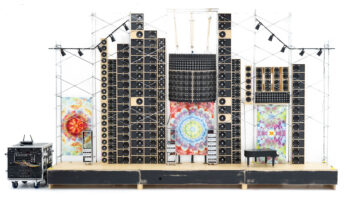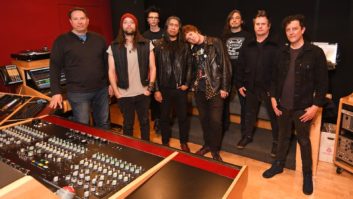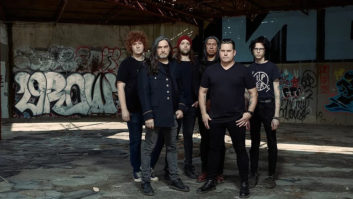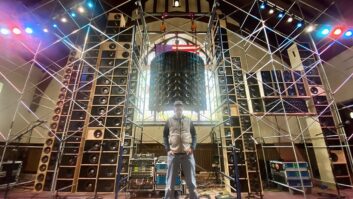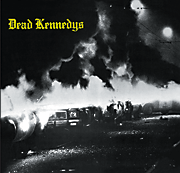

Oliver DiCicco’s San Francisco studio, Mobius Music, was only three years old in the spring of 1980. The self-taught engineer had just moved up to 16-track — a 3M 56 2-inch tape machine with iso loop — and had a couple album projects under his belt, mainly in the avant-garde and jazz realms, which allowed him to keep the lights on via live 2-track sessions of complex but generally serene music. At the time, San Francisco was fertile ground for creative new ventures; cost of living was low (shocking, I know); and the city was smaller, livable even for artists and accepting of those who wanted to follow their own path, no matter what path they chose.
Then, in what had to resemble a visit from the Tazmanian Devil, a young band with a big local buzz called Dead Kennedys — Jello Biafra, East Bay Ray, Klaus Flouride and Ted — proceeded to turn Mobius Music and DiCicco’s recording methodology upside down when they blazed through to record their full-length debut, Fresh Fruit for Rotting Vegetables. Its success not only heightened the Bay Area punk scene’s presence, but bolstered the career of one of the most important and controversial punk bands of the genre’s history.
Their biting, über-left-wing politics and Biafra’s dark humor manifested initially on the album’s first single, “California Über Alles,” an attack on California’s then-governor, Jerry Brown, who ran for the Democratic nomination for president in 1976 and 1980. He’s now the mayor of Oakland, Calif.
“‘California Über Alles’ was one of the few songs I wrote the music for while jamming on an instrument,” says Biafra, who fronted the group until their breakup in 1986 and still runs Alternative Tentacles, the label the band formed in 1979. “I generally taught tunes to the band by voice, but I was playing around on my roommate’s bass and came up with the verse riff, and the chorus just popped into my head from there. It was more influenced by Japanese Kabuki music than rock. Thus, the nasal warble of the ‘California Über Alles’ chorus.”
The original version of “California Über Alles” was played by The Healers, a band Biafra fronted in his native Boulder, Colo. Bandmate John Greenway wrote the lyrics based on Biafra’s theories about Brown. Biafra rewrote them and later used them with Dead Kennedys soon after moving to San Francisco.
“Boulder had turned into a new age yuppie hellhole long before either of those terms were used in the mainstream,” Biafra says. “There were an awful lot of people who thought they were really rebellious and free-spirited, searching for gurus to tell them what to do. This scared me. I thought, ‘What if this kind of apathy is going on in a mass scale and people just laid down until a dictator walked in.’ It’s happened in so many countries; it’s happening to our country right now. And then I thought, ‘The one politician who seemed to have a grip on the power of Eastern religious thought to manipulate people’s minds in mass, who also had a grip on the American political system, was Jerry Brown.’”
Dead Kennedys originally recorded the song in 1979 as a D.I.Y. 7-inch (flipside: “The Man With the Dogs”) at Army Street/BSU Studios, a basement 8-track facility owned by Jim Keylor. “A lot of other underground punk music was made there at the time,” says Biafra. “It was hard to find an engineer who was friendly to this kind of music because a whole generation of recording engineers had been trained to make mellow, clean, Eagles-sounding recordings. But Keylor knew what we wanted.
“One of my favorite records, production-wise, was an obscure single from England called ‘Sick of You’ by The Users,” he continues. “I showed that to Jim as kind of a guidepost for what I wanted. It didn’t come out sounding like The Users, but it did come out sounding pretty damn powerful at the time, and that helped to vault the single into another dimension as far as interest went.”
Dead Kennedys sold about 6,000 copies of that 7-inch through their newly formed Alternative Tentacles label. They took the single with them for a few New York City and Boston shows. The owner of Scotland-based record label Fast Product (Gang of Four, The Mekons, the Human League) caught one of their New York City shows and wanted to release the single in the UK. He did, and it promptly entered the Top 10 on what would now be considered the alternative charts. The single’s success also led to a UK tour, but first they needed an album to promote. Cherry Red Records funded that project, which included a re-recorded version of “California Über Alles” and “Holiday in Cambodia,” another previously released single.
The band surveyed the close-knit San Francisco studio scene, which was populated with major players such as Fantasy, The Automatt, The Plant, Coast Recorders, Different Fur and Funky Features (which later became Russian Hill), as well as a growing community of one-man operations. Based on their modest $8,000 budget and a good rapport with DiCicco, Dead Kennedys chose DiCicco’s mid-sized Noe Valley facility, which was outfitted at the time with a 16-input Quantum console, a pair of early EPI speakers and a “limited” mic collection that included U47 and U87s, a couple of 421s and a pair of KM84s.
The band set up in the main room with only a few 4-foot-high gobos between them. (There were no iso booths at Mobius at the time.) “It was kind of like a shoebox,” DiCicco recalls. “There was carpet on the floor, Fiberglas panels on the walls with burlap on them and then bare Sheetrock. It was a small room and isolation was difficult to achieve. It was probably as bare bones of a recording as you could do. It wasn’t fancy, but it was going to 2-inch 16-track, so there was plenty of tape real estate to put sound on. Tape hiss wasn’t a problem because the sound never stopped!”
Working at night after bassist Flouride punched out from his day job, the band spent a week on basic tracks, about another week on overdubs, another on background vocals, keyboards and horn overdubs, and a week to mix. For the band, tracking seemed to go relatively smoothly. DiCicco, however, had to “cram 10 pounds of sound into a five-pound bag. With just the drums and bass playing, you could hear things pretty well, but as soon as the guitar kicked in…Ray was like a wall of sound.”
That wall of sound came from a Fender Super Reverb, a DOD Overdrive preamp and Echoplex tape delay. “Guitar would go into the Echoplex first, then into the overdrive and then into the super-reverb,” Ray says. “So, actually, the echoes were distorted. As the echo’s volume goes down, since it’s not driving the amp as much, it cleans up. I also put the echo onto a swing time so it would be like a polyrhythm: If the hi-hat’s doing eighth notes and the guitar echo is doing dotted eighth notes, they would coincide like every 12 beats.”
Ray also used tricks such as overdubbing the verse riff of “Funland at the Beach” Duane Eddy — style, then molting that down in the mix; essentially, layering his guitar parts to, in the words of Biafra, “come as close as we could to capture the fire and extremities of a kick-ass live punk rock show. I was hell-bent on burning down the Hotel California!”
Meanwhile, DiCicco kept one hand on the fire extinguisher. “When you get to the point where it’s as loud as you can get, there’s no more dynamic range so it never sounds any bigger. You’ve saturated everything — the tape, the room, your ears; it’s all just loud. Biafra’s concern was that it sounded wimpy, but it was wimpy because there was no dynamic other than full-on!”
Upon the advice of famed punk producer Geza X (who recorded “Holiday in Cambodia” and “Police Truck” with the band at Tewksbury Sound prior to the Fresh Fruit sessions), Biafra also made sure every word in his lyrics packed a wallop. X also introduced the singer to higher-quality microphones and double-tracking, which added presence and power to Biafra’s distinct warble.
“At Mobius, I was using the same Neumann U47 I use now,” Biafra says. “I sang a scratch vocal in the [live] room during the basics and then re-did it. By then, I was using the technique I use today, where I usually blast through maybe three or four takes in a row, and then pick and choose which lines I like the best later. Sometimes I leave a compiled single track, but on Fresh Fruit, it’s double-tracked.”
“Biafra was relatively consistent,” adds Ray. “Part of the job was matching the level so that you can’t tell that it’s a composite. Sometimes he’d do them all in one night. We told him, ‘If you do them two days later, your voice is going to be a little bit different, and if you try to make a composite, the sound quality will be a little bit different each time.’” DiCicco often didn’t have an open track to comp vocals, so he would have to make notes and edit later.
DiCicco mixed the album to an Ampex 351 2-track machine — a straight-forward process due to a lack of automation and inputs, but challenging nonetheless. Guitars always had to be louder, with voice added on top. Ray usually stayed in the control room with DiCicco, while Biafra stayed in the upstairs lounge, where the speakers apparently sounded a lot like the ones he had at home, which gave him a good measuring stick for how the tracks would sound outside the studio. “They were mounted on the wall of the room and they had this lamp cord running up to them, so who knows what was going on with the sound of them,” adds DiCicco. “But for some reason, Biafra liked the sound of those speakers, so when we were mixing, he’d be up there listening to the mixes and yelling down to me through this door into the control room, and I’d hear him yelling and I’d think, ‘Okay I guess that means turn something up,’ and then if I didn’t get it right, he’d come in and go, ‘No, no, no, no.’ He was pretty particular about how things were going to sound. Nothing was ever fast enough or loud enough.”
Biafra counters, “Ray and Bruce [aka Ted] would argue incessantly that I was being too picky about the mix, but in the long run, I have no regrets about that. As [9 Lives cat food spokescat] Morris the Cat once said, ‘It pays to be finicky.’ People still like listening to our albums, and part of that is because somebody went the extra mile to make sure they sounded good.”
Though he had final say on the mixes, Biafra didn’t credit himself as producer. Originally, Ray didn’t either, although he was heavily involved in the production process. No, the band deferred that honor to Norm, one of DiCicco’s two cats who took a fancy to sleeping on the console. “Norm was instrumental in helping us record,” Ray says with a laugh.
After Fresh Fruit — which some cite as Dead Kennedys’ most powerful album — the band recorded Frankenchrist in 1985 with John Cuniberti at Hyde Street Studios, followed by their last official album as a band, Bedtime for Democracy. (Coincidentally, Cuniberti, who now runs The Plant Mastering in Sausalito, Calif., is remastering Fresh Fruit for Rotting Vegetables to be released this month along with a limited-edition DVD on Manifesto Records.) Bitter legal battles over Frankenchrist‘s album cover art (an HR Giger landscape of, um, body parts) propelled Biafra as a very vocal advocate for free speech and a strong opponent of Tipper Gore’s PMRC (Parental Music Resource Center). In the midst of these wranglings, the band disintegrated.
DiCicco promptly returned to recording jazz, new age and experimental music. Less than a year after Fresh Fruit‘s release, he began recording a series of albums for Windham Hill, including Winter’s Solstice and Winter’s Solstice III, among many others. He closed his studio in 2004 after a 28-year run, and now works as a designer and visual artist, builds musical instrument sculptures and leads an experimental music project, Mobius Operandi Ensemble.
Of those four weeks in early 1980, DiCicco downplays his role in one of punk music’s most memorable records. “I didn’t really know what I was doing, but maybe it was better that way,” he says. “There was a certain synergy — the band was new, the music was new, I was new — we didn’t have time to be jaded about what we were doing. We didn’t have time to think about what it all meant.”


An EQ sheet for “California Uber Alles,” the single version, recorded at BSU Studios in San Francisco
Click here to see enlarged image

Track sheet for “Kill the Poor,” recorded at Mobius Music
Click here to see enlarged image
Thank you to East Bay Ray and Eric Goodfelt, producer of the DVD portion of Dead Kennedys’ forthcoming Fresh Fruit for Rotting Vegetables reissue, for use of these images and photos.

